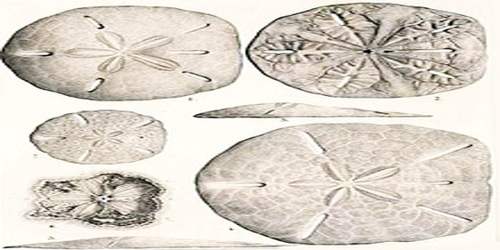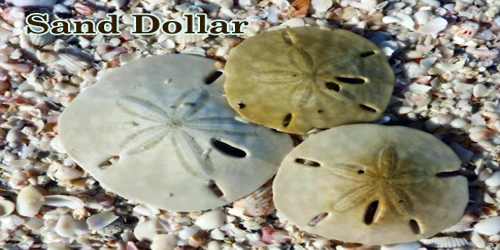Definition –
The term sand dollar (also known as a sea cookie or snapper biscuit in New Zealand, or pansy shell in South Africa) refers to species of extremely flattened, burrowing sea urchins belonging to the order Clypeasteroida. Some species within the order, not quite as flat, are known as sea biscuits. Related animals include other sea urchins, sea cucumbers, and starfish. Sand dollars can also be called “sand cakes” or “cake urchins.”
The sand dollars found on the beach today are from an ancient group of animals that has lived in the oceans for millions of years. Their bodies are often agatized by nature and then found by people who polish them into gems. This sand dollar is an agatized specimen from Mexico.
The term “sand dollar” derives from the appearance of the tests (skeletons) of dead individuals after being washed ashore. The test lacks its velvet-like skin of spines and has often been bleached white by sunlight. To beachcombers of the past, this suggested a large, silver coin, such as the old Spanish dollar (diameter 38-40mm).
Other English names for the creatures include sand cake and cake urchin. In South Africa, they are known as pansy shells from their suggestion of a five-petaled garden flower. The Caribbean sand dollar or inflated sea biscuit, Clypeaster rosaceus, is thicker in height than most.
In Spanish-speaking areas of the Americas, the sand dollar is most often known as galleta de mar; the translated term is often encountered in English.
The various common terms (sand dollar, sea biscuit, etc.) sometimes appear printed in hyphenated forms (sand-dollar, sea-biscuit).
The sand dollar is particularly well adapted for burrowing in sandy substrates. Very small spines used for digging and crawling cover the entire surface of its body and are appressed backwards toward the posterior anus. The mouth is located in the centre of the body’s underside. The upper surface exhibits pentaradiate symmetry, with a pattern of five “petals” spreading out from the centre. Some species found stranded on the shores of North America have five or six slots, or lunules, through the test (external skeleton).
Structure and Function’s of Sand Dollar –
Sand dollar, common name for a marine animal in the same phylum as the starfish. Most sand dollars measure from 5 to 10 cm (2 to 4 inches) in diameter. Species of comparable size occur in shallow coastal waters throughout the rest of the world, except in Europe and Antarctica.

The sand dollar has a rigid, flattened, disk-shaped test, or shell, made of firmly united plates lying just beneath the thin skin. Small spines that densely cover the test enable the animal to burrow in sand just below the surface. Like other members of its class, the sand dollar is radially symmetrical. It also shows evidence of a secondary bilateral symmetry, i.e., the mouth is centered on the oral (under) surface, but the anus lies near the rear edge of the test. Tube feet are similar to those in other echinoderms and are used for locomotion and to convey small food particles, mostly organic matter found in sand, to the mouth. Tube feet on the upper surface are used for respiration.
The bodies of adult sand dollars, like those of other echinoids, display radial symmetry. The petal-like pattern in sand dollars consists of five paired rows of pores. The pores are perforations in the endoskeleton through which podia for gas exchange project from the body. The mouth of the sand dollar is located on the bottom of its body at the center of the petal-like pattern.
Unlike other urchins, the bodies of sand dollars also display secondary front-to-back bilateral symmetry. The anus of sand dollars is located at the back rather than at the top as in most urchins, with many more bilateral features appearing in some species. These result from the adaptation of sand dollars, in the course of their evolution, from creatures that originally lived their lives on top of the seabed (epibenthos) to creatures that burrow beneath it (endobenthos).
Sand dollars differ from the closely related heart urchins by their shorter spines and more flattened shape. More convex, short-spined sand dollars are called sea biscuits. Sand dollars are abundant on the sandy bottom of deeper waters on both the Atlantic and Pacific coasts. They are classified in the phylum Echinodermata , class Echinoidea, order Clypeastroida.
The common sand dollar, Echinarachnius parma, is widespread from the intertidal zone to considerable depths in the ocean waters of the Northern Hemisphere. It can be found in temperate and tropical zones. The keyhole sand dollar (three species, genus Mellita) is found on a wide range of coasts in and around the Caribbean Sea.
Sand dollars like shallow waters, not far below the tide line. And they can congregate in bunches up to 600 or more in a square yard. When a sand dollar dies, its flesh quickly decomposes or gets eaten by smaller organisms. When a skeleton washes onshore, it’s bleached white.
Evolution of Sand Dollar: The ancestors of sand dollars diverged from the other irregular echinoids, namely the cassiduloids, during the early Jurassic, with the first true sand dollar genus, Togocyamus, arising during the Paleocene. Soon after Togocyamus, more modern-looking groups emerged during the Eocene.
Folklore of Sand Dollar: A variety of imaginative associations have been made by idle beachcombers who run across the bleached skeletons of dead sand dollars. They are sometimes said to represent coins lost by mermaids or the people of Atlantis. Christian missionaries found symbolism in the fivefold radial pattern and dove-shaped internal structures, and a card with an anonymous poem explaining the legend is often given in conjunction with the sale of a sand dollar by merchants. The story compares the holes with the crucifixion wounds of Christ, and other features with the Star of Bethlehem, an Easter lily, a poinsettia, and doves.
Information Sources:
















